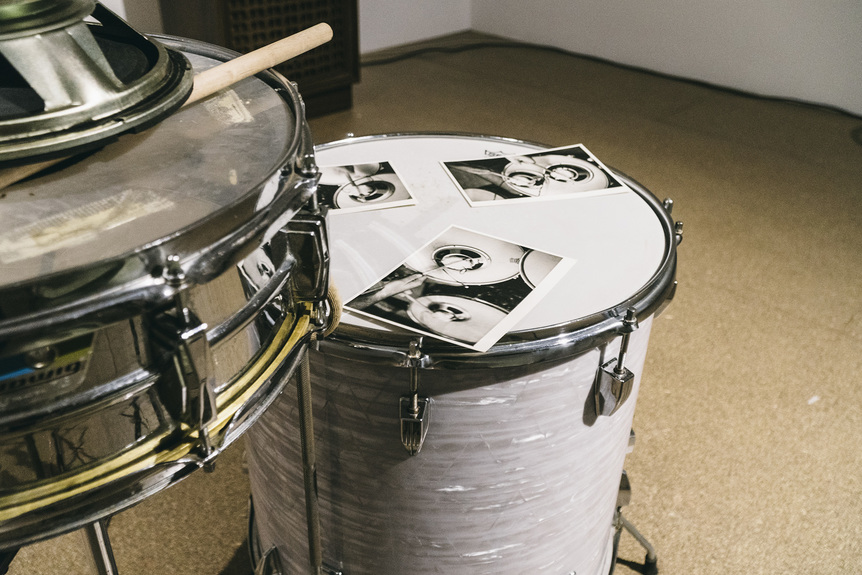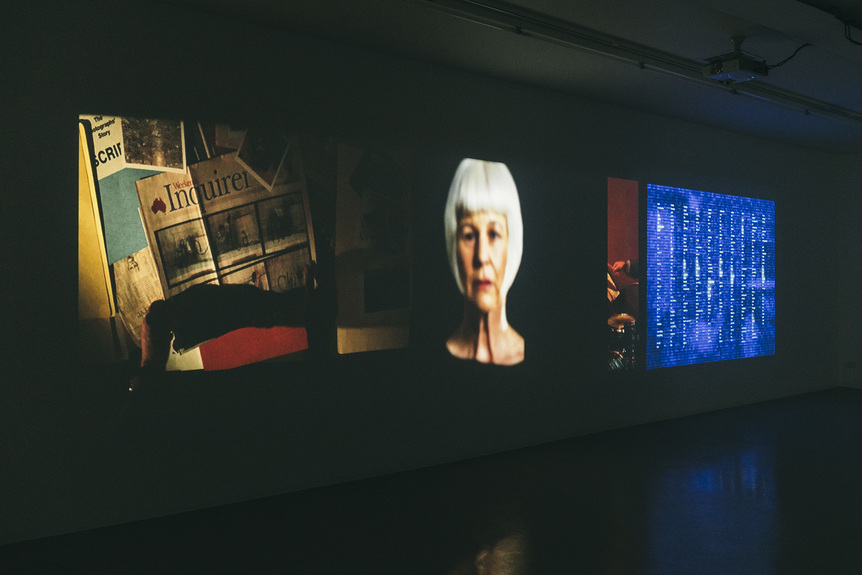-
From Current Issue
-
- Editor’s Letter Fire in the Heart
- Reviews I Gusti Ayu Kadek Murniasih
- Reviews 11th Seoul Mediacity Biennale: “One Escape at a Time”
- Dispatch Networked China
- One on One Monira Al Qadiri on Yukio Mishima
- Essays The rise of independent art spaces in pandemic-era Shanghai
- Features Tuan Andrew Nguyen
- Table of Contents
- Web Exclusives
- Archive
- Subscribe

R
E
V N
E
X
T
Installation view of PETER KENNEDY’s Snare, 1972/2019, snare drum, side drum, chair, amplifier, tape deck, speakers, drumstick, three photographs, approximately 300 × 120 × 80 cm, at “There Then Here Now,” Milani Gallery, Brisbane, 2019. All photos by Charlie Hillhouse; courtesy the artist and Milani Gallery, Brisbane.
Today, sound is so ubiquitous in Australia’s art galleries that it is easy to overlook Peter Kennedy’s profound role in making this happen. When Kennedy entered the Sydney art scene in the late 1960s, the gallery was a quiet space, free of video crackle or sonic interventions. Along with Mike Parr, Tim Johnson, and other members of the artist-run space Inhibodress, Kennedy brought a new kind of art to Australia: one that spilled off the walls into installation, neon lights, and, importantly, sound. “There Then Here Now” at Milani Gallery revealed the artist’s continued interest in sonic experience and the complex entwinement of sound and politics across his practice.
Snare, first performed in 1972 at Inhibodress, is one of the first examples of sound installation in Australian art. In the work, a recording of the artist playing the drums is transmitted via a reel-to-reel tape deck, which in turn is hooked up to a microphone installed by a snare drum. Kennedy described Snare as reversing “the conventional relationship of the drummer to drumming” such that “the artist subjects himself to being ‘played’ by his drums.” As the track reverberates onto the drum’s surface, it creates further sound waves, resulting in an odd conflation of real and recorded noise. Like much of Kennedy’s early experimentation, Snare dislocates sound from its referent, revealing autonomous echoes that seem to exist beyond human intention.
While early installations like Snare were apolitical, they paved the way for Kennedy’s later investigations. “There Then Here Now” featured a body of work titled “Chorus: From the Breath of Wings” (1993), in which Kennedy reflected on the the rise and fall of socialism and other grand narratives of the 20th century. On display were Frankensteinian objects composed of stacked TV monitors, huge aluminum loudspeakers and snare drums. Towering speakers transmit an audio soup of recordings of late-capitalist advertisements, socialist texts, and Nazi military demonstrations. The series’ title references Walter Benjamin’s allegory of the “angel of history,” which posits historical progress as a series of chaotic blasts that senselessly propel us into the future. Kennedy’s sounds are the debris of such ruptures; in the artist’s words, they linger as “memory chips in the contemporary moment.”
Kennedy’s more recent six-channel video installation, The Photographs’ Story (2004–16), springs from a single “memory chip:” six images published in the Australian (Weekend Inquirer, June 28–29, 2003) of a Palestinian child and his father, cowering behind a metal drum while being shot at, allegedly by the Israeli Defence Forces (IDF). The IDF later argued that the gunfire came from the other side of the drum, where Palestinian forces were positioned. A framed copy of the newspaper displayed at the show bears six strange phrases—“Me; da; Not; No; So; Shit e”—scribbled by Kennedy’s son, who was only a few years younger than the Palestinian boy at the time.
The Photographs’ Story returns again and again to the metal drum, as if it holds the key to the past event. Reimagining the object through sound, the film is anchored by footage of Kennedy’s son, now a teenager, playing the drums. Doublings recur throughout the film, which tells the story of the father and son in the photograph but, equally, the father and son trying to make sense of the photograph. Ultimately, it is a tale of confusion and return. The film also depicts Kennedy’s wife, Jillian, delivering a speculative narrative of the overdetermined image, while her broken phrases are transcribed on an adjacent screen. In one segment, she whispers, “Every so often he comes . . . a solitary visitor this father . . . and then . . . into the light we’re drawn . . . pulled out . . . put back . . . night again.” The disjointed text echoes the son’s nonsensical, six-word message. Like the images they haunt, these babbling sounds are fragmentary shards of the past lodged within recorded memory.
“There Then Here Now” traced Kennedy’s preoccupation with how noise from the past resurfaces in the present, highlighting the sensitivity with which he attunes his audience to the sonic reverberations of history.
Peter Kennedy’s “There Then Here Now” is on view at Milani Gallery, Brisbane, until May 18, 2019.
To read more of ArtAsiaPacific’s articles, visit our Digital Library.










